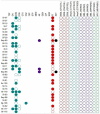Short Communication: Low Prevalence of Clinically Important Antibiotic-Resistant Strains among Non-Pathogenic Genera of the Tribe Klebsielleae
- PMID: 35954039
- PMCID: PMC9368219
- DOI: 10.3390/foods11152270
Short Communication: Low Prevalence of Clinically Important Antibiotic-Resistant Strains among Non-Pathogenic Genera of the Tribe Klebsielleae
Abstract
Hafnia sp. and Serratia sp. belong to the Tribe Klebsielleae; although they are not considered pathogenic bacteria, there are many documented cases of diseases caused by these microorganisms. The aim of this study was to determine the antibiotic resistance profiles of strains belonging to the genus Hafnia and Serratia isolated from fish and shrimps. Phenotypic antibiotic resistance was determined using the semi-automatic Vitek 2 system (bioMérieux, Marcy-l'Étoile, France), while the presence of the extended-spectrum beta-lactamase, AmpC beta-lactamases, Klebsiella pneumoniae carbapenemases and Metallo-β-Lactamase producing strains were determined using the MIC Test Strip (Liofilchem, Roseto degli Abbruzzi, Italy). As a result of the conducted research, it was observed that a vast number of Hafnia sp. strains were resistant to cefalexin (84.61%), while Serratia sp. Strains to cefuroxime (79.41%) and nitrofurantoin (85.29%). In addition, it was observed that of all strains, only one had an ability to produce enzymes typical for β-lactamase-producing Enterobacterales. Although the strains of Hafnia sp. and Serratia sp. isolated from fish and shrimp are not characterized by frequent resistance to antibiotics, taking into account the constantly growing number of antibiotic-resistant strains, this may be a problem in the future, mainly due to gene transfer through mobile genetic elements and the acquisition of resistance expressed phenotypically through contact with stress factors. Therefore, studies monitoring the antibiotic resistance profile of these species should be carried out on a regular basis.
Keywords: Hafnia sp.; Klebsielleae; Serratia sp.; antibiotic resistance.
Conflict of interest statement
The authors declare no conflict of interest.
Figures


Similar articles
-
Sickle cell disease children's gut colonization by extended-spectrum β-lactamase (ESBL)-producing Enterobacterales: an antibiotic prophylaxis effect?J Med Microbiol. 2021 Sep;70(9). doi: 10.1099/jmm.0.001414. J Med Microbiol. 2021. PMID: 34477545
-
[Analysis of antibiotic resistance and genotypes on extended spectrum β-lactamase and AmpC β-lactamase producing strains isolated from Uygur and Han newborns].Zhonghua Yu Fang Yi Xue Za Zhi. 2011 Mar;45(3):217-24. Zhonghua Yu Fang Yi Xue Za Zhi. 2011. PMID: 21624232 Chinese.
-
Extended spectrum AmpC and metallo-beta-lactamases in Serratia and Citrobacter spp. in a disc approximation assay.J Infect Dev Ctries. 2009 May 1;3(4):285-94. J Infect Dev Ctries. 2009. PMID: 19759492
-
[MULTIRESISTANT BACTERIA].Acta Med Croatica. 2015 Sep;69(3):211-6. Acta Med Croatica. 2015. PMID: 29077379 Review. Croatian.
-
AmpC β-lactamase-producing Enterobacterales: what a clinician should know.Infection. 2019 Jun;47(3):363-375. doi: 10.1007/s15010-019-01291-9. Epub 2019 Mar 6. Infection. 2019. PMID: 30840201 Review.
References
-
- Sathyavathy K., Madhusudhan K. View of Antimicrobial Susceptibility Pattern of Klebsiella Species from Various Clinical Samples at a Tertiary Care Hospital. [(accessed on 28 January 2022)];J. Pharm. Res. Int. 2020 32:143–147. doi: 10.9734/jpri/2020/v32i1230571. Available online: https://journaljpri.com/index.php/JPRI/article/view/30571/57348. - DOI
-
- Prado G.V., Mendes E.T., Martins R.C.R., Perdigão-Neto L.V., Freire M.P., Marchi A.P., Côrtes M.F., Lima V.A.C.D.C., Rossi F., Guimarães T., et al. Phenotypic and genotypic characteristics of a carbapenem-resistant Serratia marcescens cohort and outbreak: Describing an opportunistic pathogen. Int. J. Antimicrob. Agents. 2022;59:106463. doi: 10.1016/j.ijantimicag.2021.106463. - DOI - PubMed
Grants and funding
- 0130/DIA/2018/47/Ministry of Science and Higher Education
- 010/RID/2018/19/Minister of Science and Higher Education under the program entitled "Regional Initiative of Excellence"for the years 2019-2022, Project No. 010/RID/2018/19, amount of funding PLN 12,000,000 to cover an article processing charge
LinkOut - more resources
Full Text Sources
Research Materials

